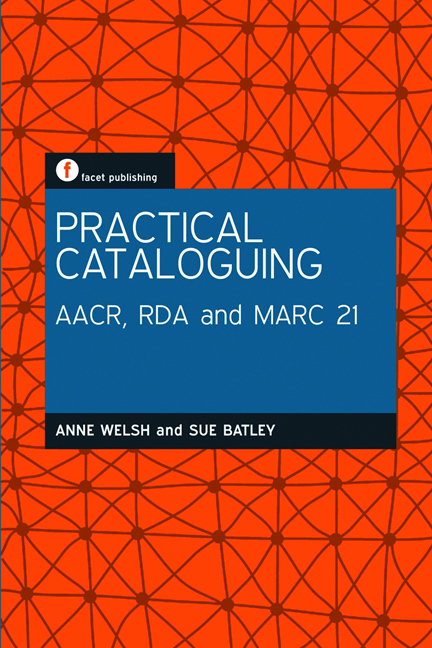Book contents
- Frontmatter
- Dedication
- Contents
- Acknowledgements
- Preface
- 1 Catalogues and cataloguing standards
- 2 The FRBRization of the catalogue
- 3 Bibliographic elements
- 4 Access points and headings
- 5 RDA: resource description and access
- 6 AACR and RDA
- 7 MARC 21
- 8 Practical cataloguing: bringing it all together
- 9 The birth of RDA and the death of MARC?
- 10 Examples
- References
- Index
8 - Practical cataloguing: bringing it all together
Published online by Cambridge University Press: 08 June 2018
- Frontmatter
- Dedication
- Contents
- Acknowledgements
- Preface
- 1 Catalogues and cataloguing standards
- 2 The FRBRization of the catalogue
- 3 Bibliographic elements
- 4 Access points and headings
- 5 RDA: resource description and access
- 6 AACR and RDA
- 7 MARC 21
- 8 Practical cataloguing: bringing it all together
- 9 The birth of RDA and the death of MARC?
- 10 Examples
- References
- Index
Summary
When we first started to write this book, we thought that the gap in the market was for a text that would describe how to catalogue from start to finish, using the new cataloguing standard, RDA.
In practice, RDA was not as close to implementation as we thought, and instead we have written a book about cataloguing standards in transition, and cataloguing practice, consequently, in flux.
So what does practical cataloguing look like during this time of change? There were two surveys of cataloguer attitudes towards RDA in 2010, one on each side of the Atlantic, and they each asked slightly different questions.
The North American survey conducted by Elaine Sanchez (Texas State University SanMarcos) attracted responses from 668 people, with 49.2% (326 respondents) working in college or university libraries and 22.5% (149 respondents) employed by public libraries (Sanchez, 2010). The survey attracted responses from all over the world, but less than 4% were from outside North America.
Sanchez has said ‘I'm a cataloguer, not a surveydesigner or statistician’ and she invited others to perform secondary analysis on her data (Sanchez, 2011). As a nonstatistician, she collected data on one of the most difficult areas for people to describe – their feelings – asking the question ‘Please select the word or words that most closely match your personal feelings toward RDA’ and eliciting a response that showed ‘Uncertainty’ out in the lead, with 388 people selecting it as (one of) their emotion(s) (Figure 8.1 overleaf).
Another interesting finding in this survey comes in response to the question ‘Please rate your knowledge of Cataloging on the Semantic Web, using the scale of 1–5, with 1 as the lowest:’ 1 “No ‘knowledge”’ and 5 as the highest ‘Expert knowledge’ (Figure 8.2). In the survey 258 respondents rated themselves at 1, while another 210 skipped the question.
These two questions in Sanchez's survey have captured a snapshot of cataloguers who feel wary about change and underconfident in the knowledge needed to embrace that change.
- Type
- Chapter
- Information
- Practical CataloguingAACR, RDA and MARC 21, pp. 159 - 166Publisher: FacetPrint publication year: 2012

